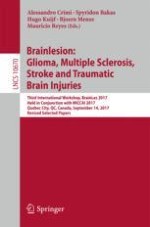2018 | OriginalPaper | Buchkapitel
Lesion Detection, Segmentation and Prediction in Multiple Sclerosis Clinical Trials
verfasst von : Andrew Doyle, Colm Elliott, Zahra Karimaghaloo, Nagesh Subbanna, Douglas L. Arnold, Tal Arbel
Erschienen in: Brainlesion: Glioma, Multiple Sclerosis, Stroke and Traumatic Brain Injuries
Aktivieren Sie unsere intelligente Suche, um passende Fachinhalte oder Patente zu finden.
Wählen Sie Textabschnitte aus um mit Künstlicher Intelligenz passenden Patente zu finden. powered by
Markieren Sie Textabschnitte, um KI-gestützt weitere passende Inhalte zu finden. powered by
